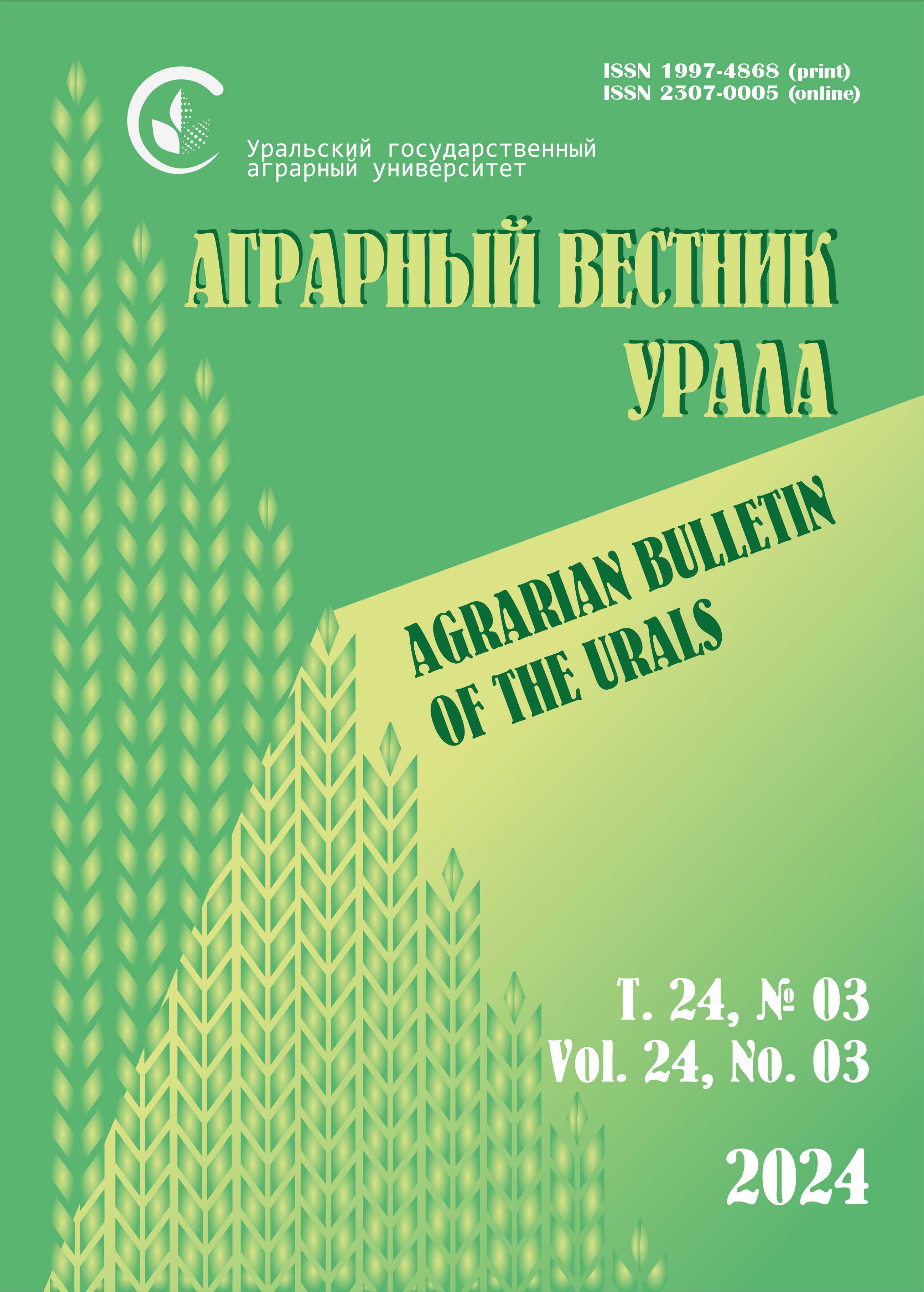Abstract. The purpose is to assess the impact of factors determining the magnitude of the environmental impact of agricultural production on land resources. Methodology and methods. In the course of the study, nonparametric statistical methods were used to identify dependencies in the data set. When constructing predictive models, ROC-analysis was used to find the values of the cut-off point. Results. The study made it possible to localize three groups of regions of the Russian Federation that differ quite significantly in terms of the environmental impact of agricultural production on land resources and are characterized by a high level of dispersion within the groups. The analysis of the interrelations between the parameters characterizing the level of environmental impact made it possible to identify factors that have a decisive influence on the indicators of reproduction of land fertility. In regions with a high negative environmental impact, only the yield value is crucial, the growth of which leads to an increase in the uncompensated removal of soil fertility elements, and, accordingly, to the progression of land degradation. In regions with an average level of negative environmental impact, its magnitude also depends on the amount of organic fertilizers applied, which forms a less high level of uncompensated removal of soil fertility elements and, accordingly, environmental damage in the regions included in this group. In the group with a positive environmental impact, it is the level of application of organic fertilizers that has a decisive influence on the reproduction of land fertility. The regression analysis showed that when approximating the values of the positive environmental impact on land resources, the amount of organic fertilizers can be the most reasonable variable. ROC-analysis regarding the application of organic fertilizers for grain crops as a potential predictive parameter of positive environmental impact showed that its threshold value at the cut-off point is 2.56 tons per 1 ha. The scientific novelty lies in the formation of the evidence base of the dependence of land fertility on the parameters of agroecological impact necessary to understand the mechanisms of building a system of rational land use in agriculture.
agriculture, land resources, regional peculiarities, fertility reproduction, efficiency, management mechanism, land policy
1. Golubev A. V. Vozmozhnosti razvitiya rastenievodstva Rossii v usloviyah global'nyh vyzovov // Agrarnyy nauchnyy zhurnal. 2020. № 11. S. 4-10. DOI:https://doi.org/10.28983/asj.y2020i11pp4-10. EDN: https://elibrary.ru/EWYYRC
2. Larionov Yu. S., Zharnikov V. B., Stukanov A. A. Formirovanie sistemy racional'nogo sel'skohozyaystvennogo zemlepol'zovaniya na osnove teorii vosproizvodstva pochvennogo plodorodiya // Vestnik SGUGiT. 2020. T. 25, № 3. S. 241–250. DOI: https://doi.org/10.33764/2411-1759-2020-25-3-241-250; EDN: https://elibrary.ru/SNQHHS
3. Nedikova E. V., Kulikova E. V. Nauchno-metodicheskie rekomendacii po predotvrascheniyu degradacii zemel'nyh ugodiy // Region: sistemy, ekonomika, upravlenie. 2022. № 2 (57). S. 102–107. DOI: https://doi.org/10.22394/1997-4469-2022-57-2-102-107; EDN: https://elibrary.ru/JMZCUX
4. Dolmatova L. G. Ekosistemnyy podhod v formirovanii racional'nogo zemlepol'zovaniya // Deutsche Internationale Zeitschrift für Zeitgenössische Wissenschaft. 2021. № 14. S. 5–8. DOI: https://doi.org/10.24412/2701-8369-2021-14-5-8; EDN: https://elibrary.ru/KLJWHS
5. Kovaleva I. V. Razvitie agroekologii v sisteme racional'nogo zemlepol'zovaniya // Social'no-ekonomicheskiy i gumanitarnyy zhurnal. 2022. № 2 (24). S. 120–131. DOI: https://doi.org/10.36718/2500-1825-2022-2-120-131; EDN: https://elibrary.ru/FWBCDS
6. Dubovickiy A. A., Klimentova E. A. Konceptual'nye i metodologicheskie podhody k formirovaniyu racional'nogo zemlepol'zovaniya v sel'skom hozyaystve // Ekonomika sel'skogo hozyaystva Rossii. 2021. № 8. S. 40–46. DOI:https://doi.org/10.32651/218-40. EDN: https://elibrary.ru/SJIYMX
7. Kriterii suschestvennogo snizheniya plodorodiya zemel' sel'skohozyaystvennogo naznacheniya: [utverzhdeny postanovleniem Pravitel'stva RF ot 22.07.2011 N 612] [Elektronnyy resurs]. URL: http://www.consultant.ru/law/hotdocs/14176.html (data obrascheniya: 24.05.2023).
8. Doklad o sostoyanii i ispol'zovanii zemel' sel'skohozyaystvennogo naznacheniya Rossiyskoy Federacii v 2020 godu. Moskva: Rosinformagroteh, 2021. 384 s.
9. Lapa V. V., Ivahnenko N. N. Parametry izmeneniya agrohimicheskih svoystv dernovo-podzolistoy supeschanoy pochvy v zavisimosti ot sevooborotov i sistem udobreniya // Pochvovedenie i agrohimiya. 2009. № 2 (43). S. 7–22.
10. Dubovickiy A. A., Klimentova E.A. Ekologo-ekonomicheskaya effektivnost' ispol'zovaniya zemel'nyh resursov: metodicheskiy aspekt // Ekonomika sel'skogo hozyaystva Rossii. 2020. № 5. S. 2–6. DOIhttps://doi.org/10.32651/205-2. EDN: https://elibrary.ru/MGBQFK
11. Dubovitski A., Klimentova E., Nikitin A. et al. Ecological and Economic Aspects of Efficiency of the Use of Land Resources // E3S Web of Conferences. 2020. Article number 11004. DOI:https://doi.org/10.1051/e3sconf/202021011004. EDN: https://elibrary.ru/NELJBX
12. Esedullaev S. T., Mel'caev I. G. Biologizirovannye sevooboroty - osnovnoy faktor povysheniya plodorodiya dernovo-podzolistyh pochv i produktivnosti pashni v Verhnevolzh'e // Agrarnyy vestnik Urala. 2019. № 11 (190). S. 18–26. DOI:https://doi.org/10.32417/article_5dcd861e3d2300.42959538. EDN: https://elibrary.ru/BQQLHO
13. Klimentova E. A., Dubovickiy A. A., Smyslova O. Yu. Racional'noe ispol'zovanie zemel'nyh resursov kak faktor povysheniya ustoychivosti sel'skogo hozyaystva // Vestnik Voronezhskogo gosudarstvennogo agrarnogo universiteta. 2023. T. 16, № 1. S. 143–155. DOI:https://doi.org/10.53914/issn2071-2243_2023_1_143. EDN: https://elibrary.ru/PPHLXE
14. Atieno M., Herrmann L., Nguyen H. T. et al. Assessment of biofertilizer use for sustainable agriculture in the great Mekong region // Journal of Environmental Management. 2020. Vol. 275. Article number 111300. DOI:https://doi.org/10.1016/j.jenvman.2020.111.
15. Gliessman S. Evaluating the impact of agroecology // Agroecology and Sustainable Food Systems. 2020. No. 4 (8). Pp. 973–974. DOI:https://doi.org/10.1080/21683565.2020.1774110.
16. Rusakova I. V. Agrohimicheskie svoystva dernovo-podzolistoy pochvy, produktivnost' kul'tur i balans elementov pitaniya pri dlitel'nom primenenii solomy // Ekologicheskiy Vestnik Severnogo Kavkaza. 2019. T. 15, № 3. S. 15–21. EDN: https://elibrary.ru/KBGXKH
17. Rublyuk M. V., Ivanov D. A., Karaseva O. V. Vliyanie komposta mnogocelevogo naznacheniya na agrohimicheskie pokazateli dernovo-podzolistoy pochvy i produktivnost' kul'tur v meliorirovannyh agrolandshaftah // Agrarnyy vestnik Urala. 2021. № 6 (209). S. 12–21. DOI:https://doi.org/10.32417/1997-4868-2021-209-06-12-21. EDN: https://elibrary.ru/NGKELS
18. La Canne C. E., Lundgren J. G. Regenerative agriculture: merging farming and natural resource conservation profitably // Peer J. 2018. Vol. 6. Article number e4428. URL: https://doi.org/10.7717/peerj.4428. (Accessed 23 July 2022).









